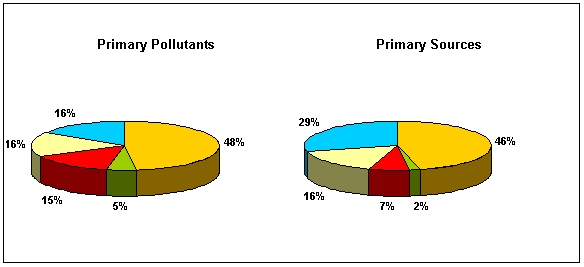| Air Pollution | |||||
| (Global issues surrounding air pollution, e.g. global warming and depletion of the ozone layer are discussed in unit 5). Both organic and inorganic materials are associated with air pollution, the box below contains some commonly recognised air pollutants. |
|||||
| Carbon Monoxide Sulphur Oxides Nitrogen Oxides Particulates Volatile organic compounds, e.g. Polycyclic aromatic hydrocarbons (PAHs) Inorganic Fluorine compounds, Inorganic Chlorine compounds, Organic oxides, Organohalides (carbon based compounds containing fluorine, chlorine, bromine or iodine), Organo nitrogen compounds, e.g. aniline |
|||||
| In general the composition of the atmosphere does not vary
by very much, approximately 99% (by volume) is made up of Nitrogen (78%),
Oxygen (20.95%), Argon (0.93%), Neon (0.002%) and other gases (0.001%),
and this remains generally stable, only the 1% remaining exhibits variation.
At such low levels (1%) it is perhaps difficult to understand how damage can be caused, but there are of course local composition variations, and in the case of buildings and lakes for example, the damage accumulates over long periods. In addition, if you consider that the average human inhales approximately 13.6 kg of air in a single day then understandably both long and short-term effects are possible. Air pollutants can be classed a primary or secondary and the effects of exposure to them as direct and indirect. Primary pollutants are those which remain unchanged from their point of origin whereas secondary pollutants are those formed after reaction in the atmosphere. For example, exposure to the primary pollutant Vinyl Chloride is known to cause cancer, i.e. a direct effect, whereas exposure to the secondary pollutants in photochemical smog or acid rain contribute to a range of effects within the environment. 
|
|||||
| Carbon Monoxide | Transportation | ||||
| Particulate Matter | Solid Waste Disposal | ||||
| Volatile Organic Components | Miscellaneous | ||||
| Nitrogen Oxides | Industrial Processes | ||||
| Sulphur Oxides | Fuel Combustion stationary | ||||
| The charts above indicate US emission %Ės of the five most common air pollutant groups, with their associated sources. These relative proportions are typical of the Northern Hemisphere countries. The main sources of carbon monoxide, sulphur and nitrogen oxides are from the burning of a variety of fuels. |
|||||